1979
Ricoh AD-1
Shutter: Program-/250
Lens: Rikenon 2.8/35 |
 |
1980
Konica C 35 EF-3
Shutter: electronic
Lens: Hexanon 2.8/35 |
 |
1980
Ricoh A-2
Shutter: Program-/250
Lens: Rikenon 2.8/35 |
 |
1980
Canon Snappy 50
A big camera family, many variations of the same idea, like: Snappy 20, Snappy '84 Olympic, Snappy S
Shutter: Program. between the lens shutter-/500
Lens: Canon 3.5/35 |
 |
1981
Chinon Bellami
Lens: Chinonex 35mm f/2,8 |
 |
1981
Konica C 35 EF3D
Shutter: electronic
Lens: Hexanon 2.8/35 |
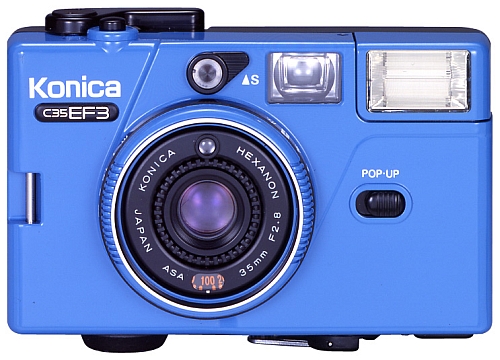 |
1981
Mamiya U
Matching the drive to ever smaller 35mm point-and-shoot cameras, the Mamiya U was introduced in July 1981. At 220g it was 90-100g lighter than the EF and AF. Using a 35mm Mamiya-Sekor f/2.8 lens (5 elements in 4 groups), it had a 4-zone manual focus (from 1.0 meter to infinity) and electronically-controlled shutter speeds from 1/8 to 1/500. It also had a self-timer and a built-in flash with a manual override. A sliding lever on the top closed the lens cover and locked the shutter. A silver-finished model was introduced in October 1981.
Lens: Mamiya-Sekor 2.8/35
|
 |
1982
OLYMPUS XA4 Macro
The XA4 Macro uses the same body as the XA, but substitutes a zone focusing 28/3.5 lens and programmed exposure.
Lens: Zuiko 2.8/28 |
 |
1982
Minolta AF C
Shutter: Program.between the lens shutter/8-/430.
Lens: Minolta 2.8/35 |
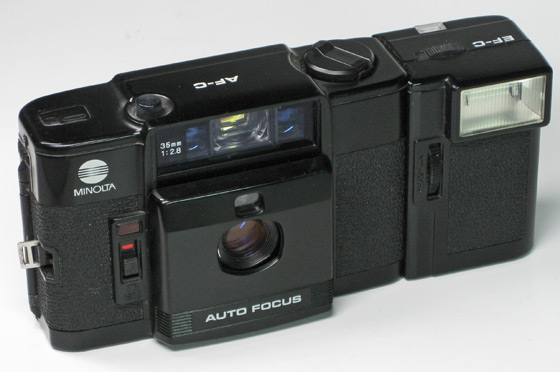 |
1982
Bauer 35 AF motor
Lens: Neovaron 2.8/35 |
 |
1982
Monami 35 FS
Shutter: Program
Lens: Chinonex 2.8/35 |
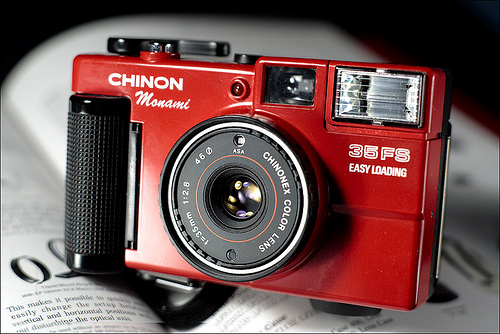 |
1983
Ricoh FF-3AFSuper (AF-9)
Shutter: electronic
Lens: Rikenon 3.2/35 |
 |
1983
Ricoh FF-3D AF
Shutter: electronic
Lens: Rikenon 3.2/35 |
 |
1983
Gomz Lomo LC-A
Lens: Minitar 2.8/32 |
 |
1983
Minolta AF-S
Minox 35 copy. Shutter: Program/625
Lens: Minolta 2.8/35 |
 |
1983
HANIMEX Amphibian
Shutter: 60 - /300
Lens: 2.8/35 |
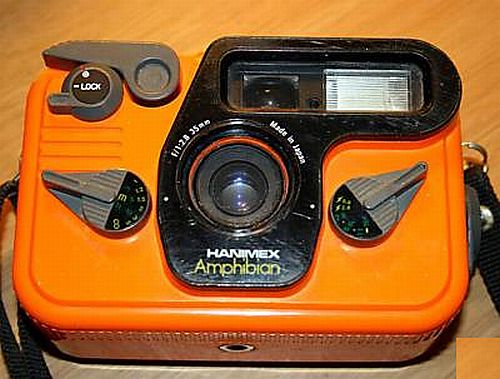 |
1983
Canon AS-6
Shutter: Program, auto advance, built-in flash
Lens: Canon 4.5/35 |
 |
1983
Canon MC
Shutter: Electronic, auto advance.
Lens: Canon 2.8/35 |
 |
1983
Nikon L35 AF Compact
first compact AF camera by Nikon. Databack version which was introduced at the same time where it provides simple data/time imprinting function, it was marked as Nikon L35 AD QD.
Lens: Nikon 2.8/35 |
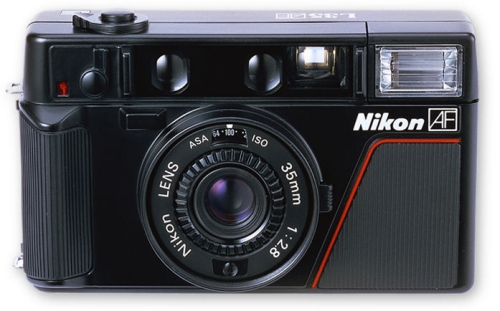 |
1984
Nikon L135 Compact
The Nikon L135AF was the second mass production Nikon compact model. It has a differed appearance from the earlier hot selling Nikon AFL35(QD), the most important it's lens aperture: 3,5 instead of 2.8.
Lens: Nikon 3.5/35 |
 |
1984
Fuji DL-200
A big camera family, many variations of the same idea, like: Fuji DL-25, Fuji DL-150, Fuji DL-15, Fuji DL-100
(Fujinon 2.8/28), Fuji DL-10, Fuji DL Super Mini, Fuji DL-30, Fuji DL-300, Fuji DL-50, Fuji DL-60, Fuji DL-7, Fuji DL-8, Fuji DL-80, Fuji DL-95 Super
Shutter: Program
Lens: Fujinon 2.8/32 |
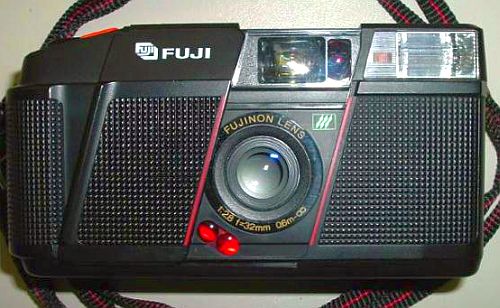 |
1984
Minolta AF-E
Shutter: Program
Shutter: Program
Lens: Minolta 3.5/35 |
 |
1985
Nikon L35AF-2 QD
The Nikon L35AF-2 QD was an upgrade from the original Nikon AF L35. It has its distinctive texture on the grip as well as the front section which can be easily distinguished from the original L35AF. The lense used was a Nikon 35mm f/2.8, similar to the previous model. In some regions, this model was also called Nikon "One-Touch".
Lens: Nikon 2.8/35 |
 |
1985
Kiev 35 A
Minox 35 EL copy.
Shutter: between the lens shutter
Lens: Korsar 2.8/35 |
 |
1985
Nikon L35 AF-2
Shutter: Program.-Automatic
Lens: Nikon 2.8/35 |
 |
1985
Pentax PC 33
a very very big family, too much Pentax PC has been done under different logos. We can consider this PC 33 like a prototype of all the family!
Shutter: Electronic/125
Lens: Pentax 4.5/35 |
 |
1985
Ricoh AF-50
large family cameras, also sold with little variations as Ricoh AF-50 D, Ricoh AF-500, Ricoh AF-505, Ricoh AF-505 D, Ricoh AF-55
Shutter: Program
Lens: Rikenon 3.5/35 |
 |
1985
Ricoh FF-70 D
Shutter: Program
Lens: Rikenon 2.8/35 |
 |
1986
Fuji DL-10
Focus free compact camera , ISO 100, 200, 400. Drop in loading.
Lens: Fujinon 5.6/35 |
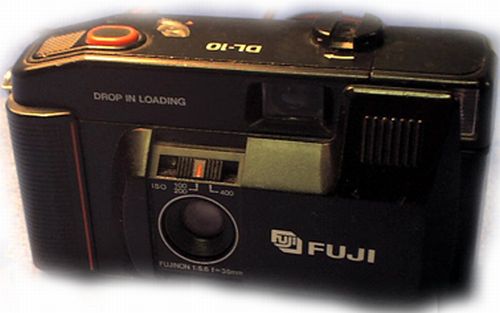 |
1986
Ricoh AF-60
also sold as Ricoh AF-60 S, Ricoh AF-70, Ricoh AF-70 D, Shutter: Program.
Lens: Rikenon 3.5/35 |
 |
1986
Minolta AF-Z.jpg
Shutter: Program./40-/800.
Lens: Minolta 2.8/35 |
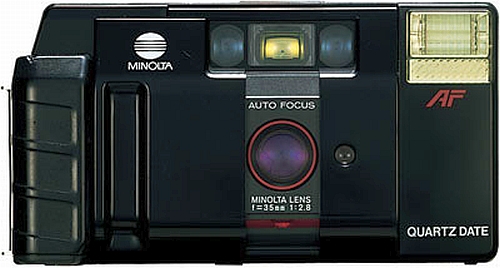 |
1986
Minolta FS-E
Shutter: Program.-Aut.-/250.
Lens: fixed focus 4.5/35 |
 |
1986
Fuji K28
Auto-exposure controlled by CdS cell, located under the lens.
Lens: Fuji 28: f.3,9 |
 |
1986
Fuji K35
Auto-exposure controlled by CdS cell, located under the lens.
Lens: Fuji 35: f.3,8 |
 |
1987
Olympus AM-100
Shutter: Program
Lens: Olympus 3.5/35 |
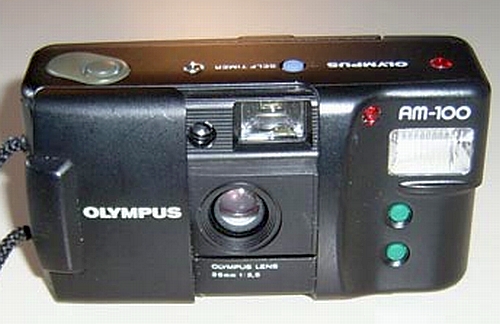 |
1987
Minolta FS-E II
(1987) A similar, simpler version of the Freeedom I. It has the same 35mm f4.5 lens, but only has speeds from 1/40 to 1/150. The DX coding can handle ISO 100 and 400 film. The built-in flash automatically turns on when the camera senses a low light situation. Auto winding and rewinding. The camera uses two R6 batteries. Shutter: Program.Aut.-/150
LLens: fixed focus 4.5/35 |
 |
1987
Minolta AF-E II
Shutter: Program
Lens: Minolta 4.5/35 |
 |
1987
Ricoh AF-500 D
also Ricoh AF-500, Shutter: Program/400
Lens: Rikenon 3.5/35 |
 |
1987
Ricoh AF-5
also Ricoh AF-55, Shutter: Program/400
Lens: Rikenon 3.5/34 |
 |
1988
Konica Genbakantoku 28 WB & 35
Auto-exposure controlled by CdS cell, located under the lens.
Lens: Konica 28mm f/3.5, 35: f.2,8 |
 |
 |
 |
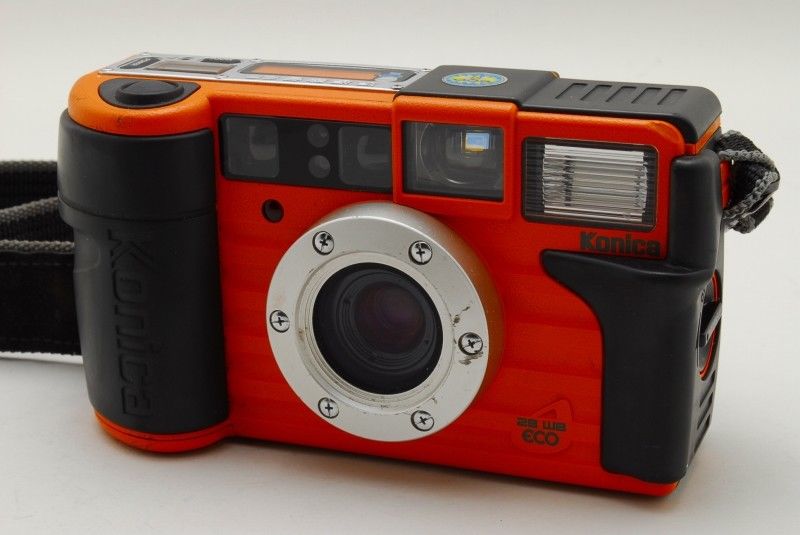 |
 |
 click on me ! ! !
click on me ! ! !


 click on me ! ! !
click on me ! ! !

